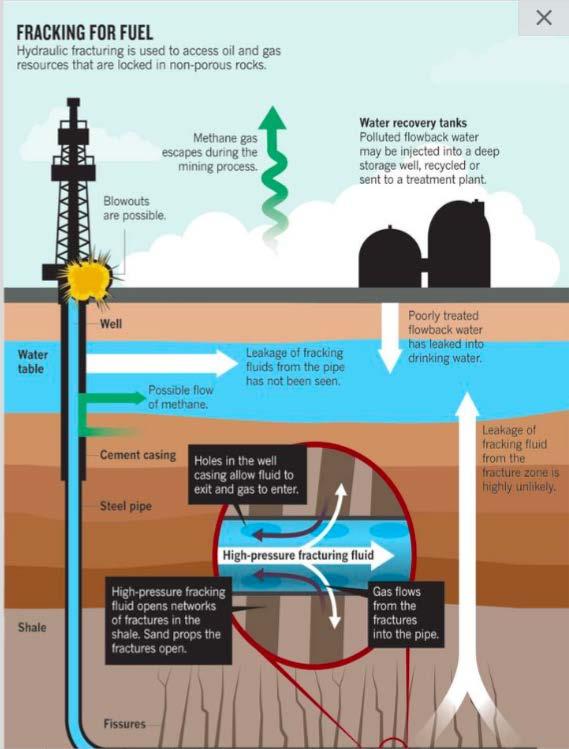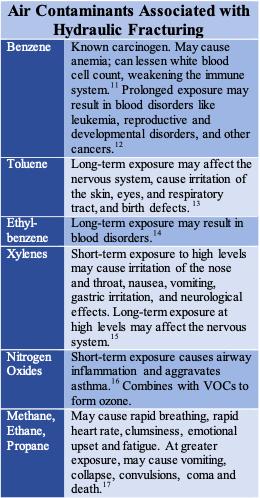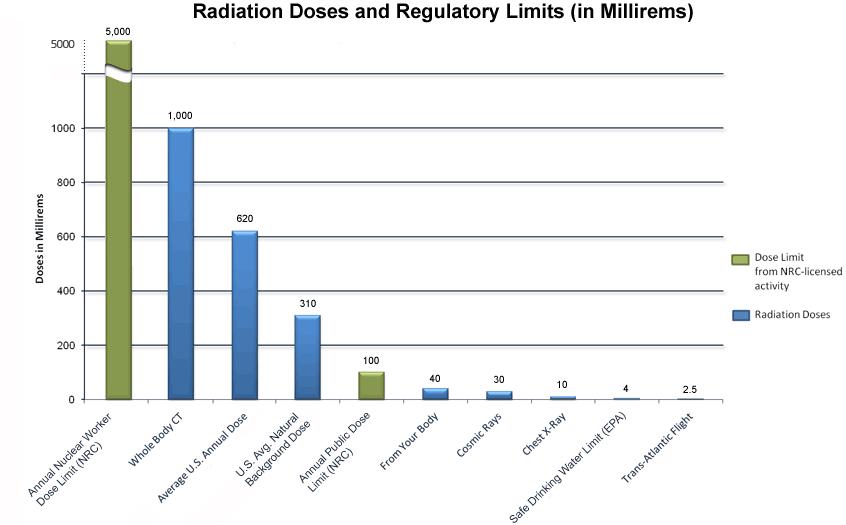
11 minute read
Pollution (I Corum, M Koh, V Varga
Introduction
In the past several decades, humans have polluted the Earth in many ways often without the consideration of the long term effects on human health. There are many different forms of pollution that take place all over the world, but this poster will focus on three: burning fossil fuels, fracking, and radiation.
Advertisement
Fossil fuels such as coal, oil, and natural gas consist of hydrocarbons that have formed over millions of years from the remains of dead plants and animals. The burning of fossil fuels by humans is the largest source of emissions of greenhouse gasses that have negative impacts on the health of humans around the world. Air pollution from the burning of fossil fuels is a major health issue as it causes serious respiratory illnesses and various diseases. It has negative impacts on pregnancies, fetal mortality rates, and disability rates.
Hydraulic fracturing is a serious problem that is also a result of the search for energy, creating air and water pollution that has negative impacts on health in a similar pattern. Fracking uses up water in a world that is already undergoing a water scarcity crisis. It negatively affects respiratory, cardiovascular and reproductive health. The effects of fracking are wide reaching and permanent.
Radiation, or radioactive waste, are fast moving subatomic particles which causes the them to be split in half and become ionized, or charged. Radiation is used to generate energy around the world, but it can cause more harm than good. When nuclear power plants fail, water and aquatic life are harmed, plant growth is inhibited, and human illnesses and cancers are created. Human and environmental health are affected when radiation is released, and there are many examples of radiation disasters.

Air pollution from an industrial power plant

Fracking site

Radiation waste
Burning Fossil Fuels
Air pollution has really only been seriously prevalent in the world since the industrial revolution (1820-1840). In the past 200 years the world has produced significant amounts of greenhouse gasses that have since accumulated in our atmosphere, leading to health issues around the word. Carbon dioxide (CO2) is the main greenhouse gas produced from the burning of fossil fuels. Different economic sectors produce more CO2 than others. The pie chart on the right (top) shows the percentage of greenhouse gas emissions per economic sector with electricity and heat production being the highest contributor and industrial processes being the second highest. The pie chart on the right (bottom) illustrates the countries responsible for the most air pollution with China being in first and the US being in second. China has double the amount of greenhouse gas emissions as compared to the US and produces the same amount as the entire world minus 5 countries.
[4]


[4]
The burning of coal is linked to many major disease states in the US. High levels of CO2 in the air coupled with the particulates produced from the burning of coal and other fossil fuels has been associated with asthma, bronchitis, heart attack, heart disease, cancer, neurological defects, deficient immune systems, and organ damage. According to the Environmental Health Perspectives, particulates produced from coal burning are 5 times as harmful to the heart as compared to burning oil or natural gas. Additionally, burning coal releases mercury and lead, which are very harmful to the nervous and immune systems. According to the National Association for the Advancement of Colored People, roughly 68% of African Americans live within 30 miles of a power plant that runs on coal. African American children are 3 times more likely to need to go to the emergency room and 2 times more likely to die from an asthma attack as compared to Caucasian children. Furthermore, Mexican people are 51 percent more likely to live in areas with higher rates of ground level ozone and their children have double the chance to die from asthma as compared to Caucasian kids. 10 people die every day in the world from asthma. [5]

In study published in 1993, Dockery and his colleagues found that levels of particles smaller than 2.5 micrometers (PM-2.5) in the air in the most polluted cities in the Midwest were linked to a 26% increase in adult death rates from all causes compared to the least polluted city. In the same study with a different sample group, they analyzed approximately 4 million infants born between 1989 and 1991 in 86 different urban areas. After taking all necessary considerations, they found that the odds ratio for mortality in infants born in areas with high levels of particle sizes less than 10 micrometers (PM-10) compared to infants born in areas with low exposure to PM-10 was 1.1 to 1. In babies with normal birth weights, high exposure to PM-10 was linked with higher incidences of sudden infant death syndrome and mortality as a result of respiratory causes. The world health administration estimates air pollution accounts for: ❖ 29% of all deaths and disease from lung cancer ❖ 17% of all deaths and disease from acute lower respiratory infection ❖ 24% of all deaths from stroke ❖ 25% of all deaths and disease from ischemic heart disease ❖ 43% of all deaths and disease from chronic obstructive pulmonary disease
Fracking
Fracking or hydraulic fracturing is a method used to extract natural gas and oil from deep rock formations known as shale. Water, sand, and a mix of chemicals are forced into the horizontally drilled wells to crack the shale to release the gas or oil. This method poses many health risks to those around drilling sites, ranging from respiratory, cardiovascular, nervous, and reproductive problems.
Air
Hydraulic fracturing has a heavy impact on air quality. This occurs primarily from the emissions released during drilling. Engines used during well preparation, drilling and production is one problem. Fine diesel soot particles lodge into the lungs from the diesel emissions of the engines. The effects of drilling on drill workers are similar to coal miners. [8]

[9]

Another problem that occurs from drilling are the volatile hydrocarbons and toxics released during drilling. Oil/gas formation contain hydrocarbons and other gases. Benzene, one toxic hydrocarbon, was found to be often higher than the minimum risk levels set by the CDC in a study by the West VA department of Environmental Protection. Another example is Hydrogen Sulfide, which is produced along with the hydrocarbons that damages the CNS. This can cause nervous system problems.
The sand (silica) used during fracking can also lead to silicosis, which is an irreversible lung disease. NIOSH researchers collected 111 personal breathing zone samples at 11 sites in 5 states to discover that full-shift samples exceeded occupational health criteria, with some samples exceeding 10x more. This means that even with proper airpurifying respirators, protection is inadequate as it exceeds the masks’ max use concentration.

Water
The 2005 Energy Policy Act exempts hydraulic fracturing from key provisions of the Safe Drinking Act through the “Halliburton loophole”. The oil and gas sector are permitted to inject known hazardous materials near or directly into underground drinking water aquifers, routine monitoring is not required and companies are not compelled to fully disclose identity of chemicals used in fracking. These chemicals used are extremely hazardous to human health. Of the more than 1,000 chemicals confirmed as ingredients in fracking fluid, an estimated 100 are known endocrine disruptors, or act as reproductive and developmental toxicants. Others are heavy metals, radioactive elements, brine, and volatile organic compounds. These toxic substances can leak into surrounding watersheds, streams and aquifers.
PA has determined that 343 private drinking water wells have been contaminated or otherwise as a result of drilling and fracking operations over an 8yr period. A 2017 study found that spills of fracking fluids and fracking wastewater are common, documenting 6,678 significant spills occurring over a period of nine years in four states alone. Between 2 and 16 percent of wells report spills each year in these 4 states. About 5 percent of all fracking waste is lost to spills, often during transport.
Radiation
Radiation, or radioactive waste, are fast moving subatomic particles which causes the particles to be ionized, or charged. Radiation is used to generate power via nuclear power plants. The U.S. uses nuclear power plants to generate 20% of the country’s power. The power plants heat water to move big turbines via nuclear fission. The nuclear fission is what generates the radioactive particles. Radioactive waste can cause local and global pollution. Some examples include Chernobyl and Fukushima. These power plants are famous examples of the harm and destruction radiation may cause. Radiation has caused numerous cancers in persons near the nuclear disasters, and some environmental issues as well.

https://en.wikipedia.org/wiki/Radiati on_effects_from_the_Fukushima_Dai ichi_nuclear_disaster
Air
Radioactive waste does not directly affect air quality, but it does affect the travel of radioactive particles. While radioactive particles are invisible to the naked eye, it is still able to travel. Radioactive particles are carried in the wind to other areas and affect many other persons. Radioactive particles causes cancer and genetic mutation in wildlife and humans. DNA replication is disrupted and accelerated leading to cancer. Genetic mutations can also be passed on to offspring, leading to illnesses and depletion of a species. An example of a species affected by radiation are seals. Off the coast of Russia, the seal population was slowly decreasing. This is believed to be due to the over exposure of radiation from Chernobyl.
Water
Radioactive particles can interact with water molecules and become ionized. When water molecules become ionized, they may gain more molecular weight. This causes the particles to sink to the bottom of an ocean, for example, and interact with seaweed. In this case, aquatic animals such as shrimp, crucians, and some fish will become radioactive as well. Other sea life will ingest the radioactive creatures, and so on. This affects sea life and even humans in the case of fishing. After Fukushima, Yale’s School of Forestry and Environmental Studies measured ocean radiation levels were taken off the coast of Japan up to 100 miles away. The water was shown to be contaminated many months later in 2011.
Land
Plant life is not affected by radiation. Since plants can with stand UV radiation, they were able to with stand radioactive particles. Seeds, however, are unable to sprout. New plant life cannot grow due to nitrogen, phosphorous, and other elements in soil become less nutrient rich.

https://www.nrc.gov/about-nrc/radiation/around-us/doses-daily-lives.html
Personal Opinions

It is clear that all three forms of pollution that we have covered in this poster have major impacts on human health around the world. Air pollution has correlation and causation to increased rates of various respiratory illnesses, cardiovascular illnesses, and others. If the world does not come together to make a global effort to end or significantly reduce the amount of burning of fossil fuels by converting to electric cars and other forms of renewable energy, the rates of death from these illnesses will only continue to increase. A larger transition to more renewable forms of energy would decrease usage of hydraulic fracturing and improve overall health. Much of the drive for fracking is due to energy companies seeking out nonrenewable resources such as oil and gases. If energy companies were made responsible for their drilling areas, fracking would be less dangerous. Radioactive energy has been around for a long period of time, but it has caused more harm than good. Environmental disasters have occurred such as Chernobyl, an uninhabitable area for thousands of years due to a radiation disaster.
References

[1] The Localized Health Impacts of Fossil Fuels. Climate Nexus. https://climatenexus.org/climate-issues/health/the-localized-health-impacts-of-fossil-fuels/. Published November 14, 2019. Accessed February 15, 2020. [2] 10 Health Problems from Fossil Fuels. Arcadia. https://blog.arcadia.com/10-health-problems-fossil-fuels/. Published August 9, 2017. Accessed February 15, 2020. [3] Grigg J. The health effects of fossil fuel derived particles. Archives of Disease in Childhood. 2002;86(2):79-83. doi:10.1136/adc.86.2.79. [4] Global Greenhouse Gas Emissions Data. (2019, September 13). Retrieved March 26, 2020, from https://www.epa.gov/ghgemissions/global-greenhouse-gasemissions-data [5] Mendez, K. (2019, November 22). Asthma Capitals 2019: The Most Challenging Places to Live With Asthma. Retrieved March 26, 2020, from https://www.aafa.org/asthma-capitals/ [6] Mallard, S., Maise, E., DeGroot, L., & Park, J. (2019, August 19). Particulate pollution responsible for worldwide disease rates: study. Retrieved March 26, 2020, from https://www.gwhatchet.com/2019/08/18/particulate-pollution-responsible-for-worldwide-disease-rates-study/ [7] Bushkin-Bedient S, Dyrszka L, Gorby Y, et al. Compendium of Scientific, Medical, and Media Findings Demonstrating Risks and Harms of Fracking. Physicians for Social Responsibility. Available at: https://www.psr.org/wp-content/uploads/2019/06/compendium-6.pdf. Accessed February 11, 2020 [8] Hoffman J. Potential Health and Environmental Effects of Hydrofracking in the Williston Basin, Montana. National Science Foundation. Available at: https://serc .carleton .edu/NAGTWorkshops/health/casestudies /hydrofrackingw.html. Accessed February 12, 2020. [9] Hydraulic Fracturing and Your Health: Air Contamination. Physicians for Social Responsibility. Available at: https://www.psr.org/wpcontent/uploads/2018/05/ fracking-and-air-pollution.pdf. Accessed February 11, 2020 [10] Marusic K. After a decade of research, here's what scientists know about the health impacts of fracking. Environmental Health Network. Available at: https://www.ehn.org/health-impacts-of-fracking-2634432607.html. Published November 18, 2019. Accessed February 12, 2020. [11] Srebotnjak T, Rotkin-Ellman M. NRDC. Fracking Fumes: Air Pollution from Hydraulic Fracturing Threatens Public Health and Communities. Available at: https://www.nrdc.org/sites/default/files/fracking-air-pollution-IB.pdf. Accessed February 11, 2020










